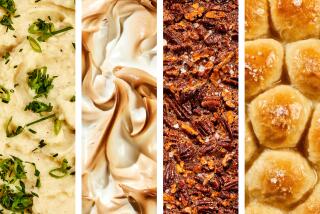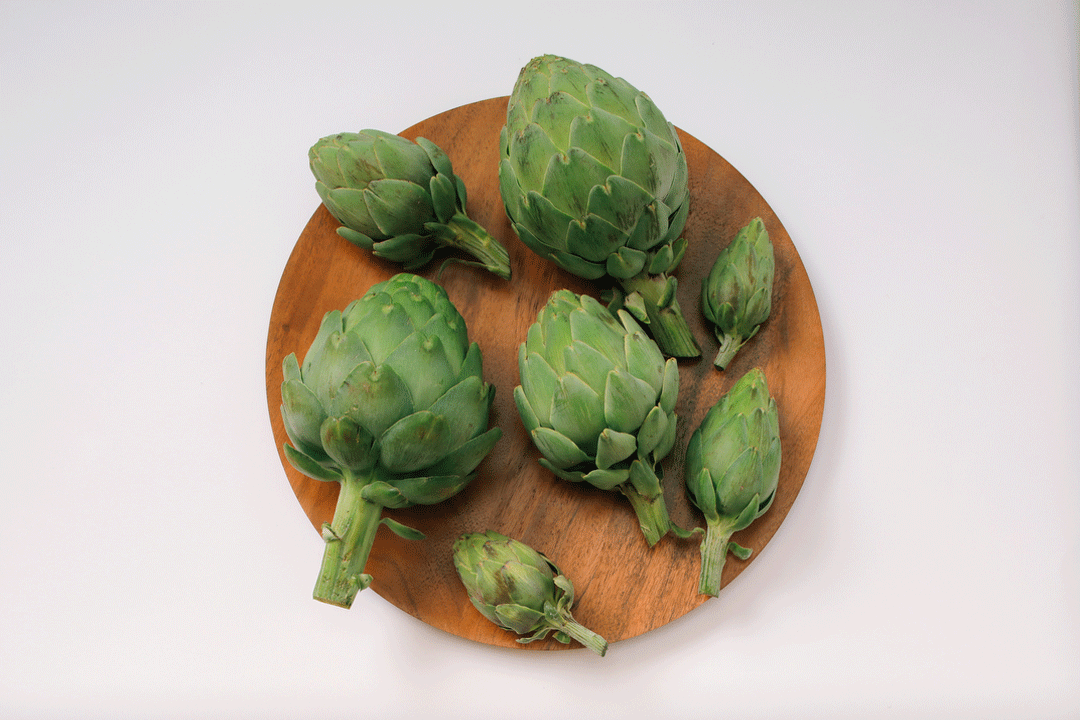The Global Gobbler
- Share via
Americans and Canadians may be the only people to celebrate Thanksgiving, but we are certainly not alone in our fondness for turkey as the star of holiday dinners. Europeans love it too.
The French dinde de Noel , or Christmas turkey, is often stuffed with chestnuts, and so is Austrian roast turkey. Italians serve turkey for the winter holidays, flavoring it with sage and rosemary, basting it with pomegranate juice or filling it with a mixture of chestnuts, sausage, apples and prunes. In Spain, turkey might have a bread stuffing accented with lemon, cinnamon and raisins. And across the Strait of Gibraltar, a spice-scented Moroccan turkey comes with couscous .
However, European and Mediterranean cooks have an easier time cooking turkey than we do. Their whole turkeys weigh five or six pounds, about the size of a roasting chicken. Our turkeys are so heavy that when I roast one, I have to ask my husband to turn it over.
Fortunately, our markets offer a faster, simpler way to serve a roast turkey for Thanksgiving. Now turkey breast roasts are readily available. They are much quicker to roast--instead of taking several hours, a turkey half-breast can be ready in an hour and a half. If you’re buying frozen turkey, these smaller roasts thaw more quickly. They don’t require trussing and they’re easier to carve.
But turkey breast roasts have another great advantage: Their meat comes out moister than the breast meat of a whole turkey because it doesn’t have to sit in the oven and wait for the leg meat to cook to the right temperature. The result is all lean, white meat that is not dry. Depending on how many people you want to serve, you can buy a whole or half breast. Boneless breasts are available too, but I find that turkey breasts with the bone in make more succulent roasts.
Stuffing a large turkey makes the bird’s roasting time even longer. With turkey breasts, stuffing can be baked separately. Basting the stuffing a few times with the turkey’s roasting juices or with chicken or turkey broth will give it the traditional “poultry” flavor it gets when cooked inside the bird.
A turkey breast should be basted, but you need to baste it only four or five times during roasting. And you don’t have to use a lot of butter--a few tablespoons of olive oil work just fine for basting and make a savory base for a Mediterranean-style sauce.
For the gravy, I prefer to make a light sauce, thickened with a little potato starch rather than with a heavier roux of butter and flour, or to simply serve the roasting juices on the side. Placing onions and carrots in the roasting pan with the turkey is a trick I learned from French chefs for adding flavor and a richer brown color to the sauce. Occasionally I roast red peppers around the turkey, which not only flavor the juices but make a tasty accompaniment.
A Moroccan-style cumin-garlic seasoning paste gives a delicious flavor to this easy turkey roast as well as to the red peppers and onions that roast alongside it. Serve the turkey and peppers with the zesty roasting juices and with rice stuffing or couscous.
ROAST TURKEY BREAST WITH CUMIN AND PEPPERS
1 (2 3/4- to 3-pound) turkey breast half, skin on and bone in
2 onions, quartered
Salt, pepper
3 tablespoons olive oil
6 cloves garlic, minced
1/4 teaspoon cayenne pepper
2 teaspoons ground cumin
1 teaspoon paprika
2 sweet red peppers, each cut into 4 or 6 pieces
Place turkey breast in roasting pan, bone-side down, along with onions. Season turkey to taste with salt and pepper. Combine olive oil, garlic, cayenne, cumin and paprika and rub mixture all over turkey with back of spoon.
Roast turkey at 400 degrees 15 minutes. Reduce oven temperature to 350 degrees and roast 30 minutes longer. Baste turkey. Add red pepper pieces to pan. Roast 20 minutes longer. Baste turkey and turn peppers over. Continue roasting about 30 minutes longer or until meat thermometer or instant-read thermometer (inserted in thickest part of meat, not touching bone) registers 170 degrees. Cover turkey if it becomes dark brown.
Carve turkey into thin slices and serve with juices and roasted vegetables. Makes 4 or 5 servings.
Saffron, nuts and raisins give this flavorful rice stuffing an exotic touch. It is perfect with all of these recipes or with any simple roasted turkey or chicken.
AROMATIC RICE STUFFING WITH PISTACHIOS, ALMONDS AND RAISINS
3 1/2 cups chicken broth or water
1/4 teaspoon crushed saffron threads
1/4 cup oil
1 cup minced onions
1 3/4 cups long-grain white rice
1/2 teaspoon salt
Freshly ground pepper
1/2 cup dark raisins
1/2 cup slivered almonds, toasted
1/2 cup shelled toasted pistachios
Bring chicken broth to boil in medium saucepan. Add saffron. Cover and keep warm over low heat.
Heat oil in large oven-proof saute pan or deep skillet over low heat. Add onions and cook, stirring, about 7 minutes or until tender but not brown. Increase heat to medium. Add rice and saute, stirring, about 4 minutes or until grains begin to turn milky white.
Return broth to boil over high heat. Pour over rice and stir once. Add salt and season to taste with pepper. Bring to boil. Cover pan and transfer to oven.
Bake at 400 degrees 10 minutes. Stir in raisins. Cover and bake 8 to 10 minutes longer or until rice is just tender. Lightly mix in almonds and pistachios. Taste and adjust seasonings. Makes 4 to 5 servings.
Note: If saffron is not available, simply omit it. Stuffing will still have plenty of flavor.
Mediterranean flavors give this roast its fine taste. It is elegant, simple to prepare and suitable for Thanksgiving or for entertaining any time of the year. For a fall or winter holiday meal, serve it with braised chestnuts, glazed carrots and mashed potatoes.
ROAST TURKEY BREAST WITH SAGE AND THYME
1 (3-pound) turkey breast half with skin and bones
1 large onion, quartered
1 large carrot, quartered
20 fresh sage leaves or 1 teaspoon dried
3 tablespoons olive oil
1 teaspoon dried thyme
Salt
Freshly ground pepper
1/2 cup dry white wine
3/4 cup chicken broth
1 tablespoon potato starch or cornstarch, dissolved in 2 tablespoons water
1 tablespoon chopped fresh sage or 1 teaspoon dried
1 tablespoon chopped parsley
Place turkey breast in roasting pan along with onion and carrot. Slip about 10 fresh sage leaves (not dried sage) under turkey skin. Rub turkey with oil. Sprinkle with thyme and dried sage, if using. Season to taste with salt and pepper. Place remaining sage leaves in pan under turkey.
Roast turkey at 400 degrees 15 minutes. Baste with pan juices. Reduce oven temperature to 350 degrees and roast turkey, basting every 20 minutes, about 1 1/4 hours or until meat thermometer or instant-read thermometer inserted in thick part of meat, not touching bone, registers 170 degrees.
Remove turkey to board, leaving vegetables in pan. Cover turkey. Skim fat from pan juices. Add wine and bring to simmer, scraping browned juices into wine. Pour liquid with vegetables into saucepan. Add broth and simmer 2 or 3 minutes. Strain into bowl and return to saucepan. Bring to simmer. Stir potato starch mixture and whisk into simmering broth. Simmer 1 to 2 minutes until thickened. Stir in chopped sage and parsley. Add juices from turkey board. Adjust seasonings to taste. Cut turkey into thin slices and serve with sauce. Makes 4 servings.


